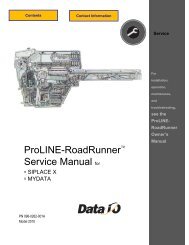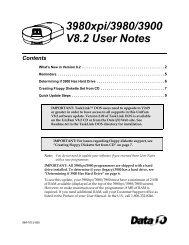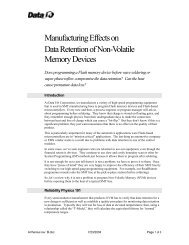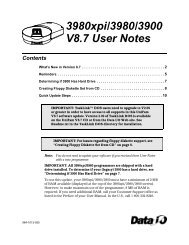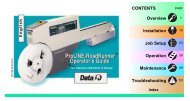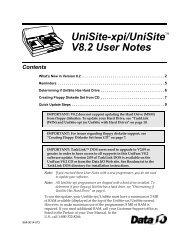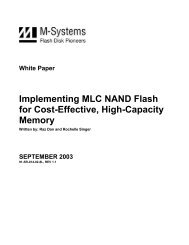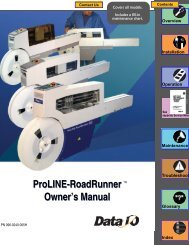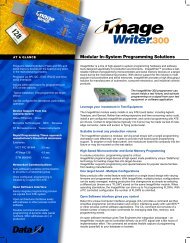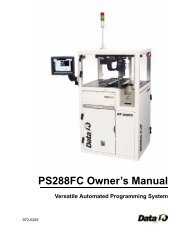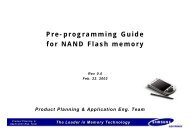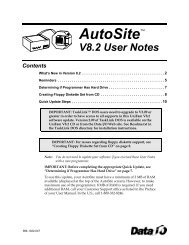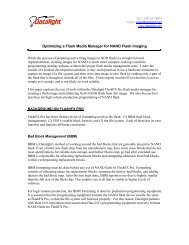What is NAND Flash Memory? - Data I/O Corporation
What is NAND Flash Memory? - Data I/O Corporation
What is NAND Flash Memory? - Data I/O Corporation
Create successful ePaper yourself
Turn your PDF publications into a flip-book with our unique Google optimized e-Paper software.
<strong>What</strong> <strong>is</strong> <strong>NAND</strong> <strong>Flash</strong> <strong>Memory</strong>?March ‘03File <strong>Memory</strong> Marketing & Promotion Department<strong>Memory</strong> Div<strong>is</strong>ionTOSHIBA Semiconductor CompanyCopyright © 2003 Toshiba <strong>Corporation</strong>. All rights reserved.
<strong>NAND</strong> <strong>Flash</strong> <strong>Memory</strong> Concept• Suitable for file storage- File memory architecture- Page programming (512 bytes/page)• High performance- High speed programming and erasing• Low cost- Small chip size based on <strong>NAND</strong> Structure- Small pin count• Easy memory expansion- Simple interface by command controlCLE/CE/WESystem BusI/O1 - I/O8/CE/RE/WER/BYCLEALE/WP<strong>NAND</strong><strong>Flash</strong>ALEI/O 1-8 CMD Add Add AddCommandInputAddress Input
<strong>NAND</strong> vs. NOR - Cell Structure<strong>NAND</strong>Word lineNORBit lineContactWord lineCellArrayUnit CellUnit CellLayoutSource line2F2FSource line5F2FCrosssectionCell size4F 210F 2
<strong>NAND</strong> / NOR Character<strong>is</strong>ticsCapacityPower SupplyI/OAccess TimeProgramSpeed (typ.)EraseSpeed(typ.)Prog+Erase(typ.)<strong>NAND</strong>~ 1Gbit (2chips/pkg)2.7-3.6Vx850ns(serial access cycle)25µs(random access)200µs/512Byte2ms/Block (16KB)33.6ms / 64KBNOR~ 128Mbit2.3-3.6Vx8/x1670ns(30pF, 2.3V)65ns(30pF, 2.7V)8µs/Byte4.1ms/512Byte700ms/Block1.23s/Block (main:64KB)
<strong>NAND</strong> <strong>Flash</strong> <strong>Memory</strong> Block Diagramex.256Mb <strong>NAND</strong> <strong>Flash</strong> <strong>Memory</strong>8bit(512+16Byte)Reg<strong>is</strong>terSG (D)Bit LineBasic unitWL1WL2PageCell Array512Byte16Byte32page/BlockRedundant CellArrayWL3WL4(WL30)(WL31)(WL32)SG (S)~~256Mb <strong>NAND</strong> <strong>Flash</strong>Page Size : 512+16 BytesBlock Size : 16KBytes# of Blocks : 2048 Blocks
<strong>NAND</strong> <strong>Flash</strong> <strong>Memory</strong> Basic Function (1)Read1page ReadReg<strong>is</strong>terHigh SpeedSerial Read< Timing Chart>CElowALECLEWEREI/O1~8Command00H Col Row1 Row2DN DN+1 D527R/BAddressNAddress AddressWait(tR) <strong>Data</strong>-Out <strong>Data</strong>-Out <strong>Data</strong>-Out(ex. 256Mb <strong>NAND</strong> <strong>Flash</strong> <strong>Memory</strong>)
<strong>NAND</strong> <strong>Flash</strong> <strong>Memory</strong> Basic Function (2)Program<strong>Data</strong> InputReg<strong>is</strong>terPage1pageProgramBlock< Timing Chart >CElowALECLEWEREhighCommandCommandI/O1~880H Col Row1 Row2D0 D1 D527 10HWait(tPROG)R/BAddress Address Address<strong>Data</strong>-In <strong>Data</strong>-In <strong>Data</strong>-In(ex. 256Mb <strong>NAND</strong> <strong>Flash</strong> <strong>Memory</strong>)
<strong>NAND</strong> <strong>Flash</strong> <strong>Memory</strong> Basic Function (3)EraseReg<strong>is</strong>terBlock Erase(32page)< Timing Chart >CElowALECLEWEREhighCommandCommandI/O1~860H Row1 Row2D0HWait(tERASE)R/BAddressAddress(ex. 256Mb <strong>NAND</strong> <strong>Flash</strong> <strong>Memory</strong>)
<strong>NAND</strong> <strong>Flash</strong> Control in System< Required Items >1. <strong>NAND</strong> <strong>Flash</strong> File Management- Bad Block Management- Wear Leveling Treatment2. ECC Support- 1 bit/page error correctionand 2bit/page error detection*** ECC : Error Correction Code* * : 2LC <strong>NAND</strong> <strong>Flash</strong> 1bit/page ECC
Invalid block detection at IncomingNumber of valid blocks at shippingType.Min. Max.StartTC58V6410141024Block No = 1TC581281004 1024Read CheckFailTC58256 2008 2048TC58512 4016 4096Block No. = BlockNo. + 1PassBad Block *1TH58100 8032 8192NoBlock No. = Last BlockInvalid blocks have to be detected bybad block test flow before erasing.• Invalid block : include “0” data. Th<strong>is</strong> “0”data may be lost by erasing.• Valid block : has only “1” data.EndYes< Read Check >Read the 1st page of each block. If byte 517 ofthe 1st page <strong>is</strong> not FF (Hex), define the block asa bad block. The 1st block in the device <strong>is</strong>guaranteed to be good at time of shipment.*1 : No erase operation <strong>is</strong> allowed to bad blocks
<strong>NAND</strong> <strong>Flash</strong> <strong>Memory</strong> Basic Specification0.16umTC58V64BFTTC58128AFTTC58256AFTTC58512FTTH58100FT64Mb 128Mb 256Mb 512Mb 1GbDensity(8M+256K)x8(16M+512K)x8(32M+1M)x8(64M+2M)x8(128M+4M)x8Operation voltage2.7V-3.6V← ← ←←Page size ( program unit )512B+16B← ← ←←Block size ( erase unit )8KB+256B16KB+512B←←←Number of Pages per Block1632←←←Number of Blocks1024 1024 2048 40968192Number of Address cycle3←←4←Random access time ( us )Serial access time ( ns )Package400mil / 0.8mmTSOP type II25us (max.)50ns (min.)TSOP I 48-P-1220-0.50
2 Type Read FunctionType 1 (TSOP Package)/CE/WE/RESequential Read(00H)0A527R/BMNBusy<strong>Data</strong> OutputI/O00HStart-address inputSequential Read (1)Sequential ReadType 2 (BGA/MCP Package)/CE/CE don’t careNo Sequential ReadM527/WE/RER/BMNBusy<strong>Data</strong> OutputSelectpageNCellarrayI/O00HStart-address inputFigure 3. Read mode (1)operationNext Add. Input
TSOP PackagePackage TypeTSOP-II 44-P-400-0.8TSOP-I 48-P-1220-0.50Top ViewV SS1CLE2ALE3WE 4WP 5I/O 1 18I/O 2 19I/O 3 20I/O 4 21V SS22( W )44434241402726252423V CCCERER/BOPI/O 8I/O 7I/O 6I/O 5V CC( L )NCNCNCNCNCOPR/BRECENCNCVccVssNCNCCLEALEWEWPNCNCNCNCNC123456789101112131415161718192021222324( W )484746454442424140393837363534333231302928272625NCNCNCNCI/O8I/O7I/O6I/O5NCNCNCVcc ( L )VssNCNCNCI/O4I/O3I/O2I/O1NCNCNCNCPackagedimensions&Closesection View&<strong>Memory</strong> P/NSingleStacked18.41(L) x 11.76(W) x 1.2 (max) mm64Mbit : TC58V64BFT12.0(L) x 20.0(W) x 1.2 (max) mm128Mbit : TC58128AFT256Mbit : TC58256AFT512Mbit : TC58512FT12.0(L) x 20.0(W) x 1.2 (max) mm1Gbit : TH58100FT
CSP Outline Drawing256M/128M <strong>NAND</strong> <strong>Flash</strong> CSPPackage SizeDesign rule0.16um 0.13um256M : 9mm X 11mm 7mm X 10mm128M : 7mm X 10mm 7mm X 10mm( 7x10 : no dummy ball )Top View1.60.8Bottom View111.60.85.694.0: Contact Balls1.2max: Index Mark Ball0.47 typ.: Dummy Balls
The information contained herein <strong>is</strong> subject to change without notice.The information contained herein <strong>is</strong> presented only as a guide for the applications of our products. No responsibility <strong>is</strong> assumedby TOSHIBA for any infringements of patents or other rights of the third parties which may result from its use.No license <strong>is</strong> granted by implication or otherw<strong>is</strong>e under any patent or patent rights of TOSHIBA or others.TOSHIBA <strong>is</strong> continually working to improve the quality and reliability of its products.Nevertheless, semiconductor devices in general can malfunction or fail due to their inherent electrical sensitivity and vulnerabilityto physical stress.It <strong>is</strong> the responsibility of the buyer, when utilizing TOSHIBA products, to comply with the standards of safety in making a safe designfor the entire system, and to avoid situations in which a malfunction or failure of such TOSHIBA products could cause loss ofhuman life, bodily injury or damage to property.In developing your designs, please ensure that TOSHIBA products are used within specified operating ranges as set forth in themost recent TOSHIBA products specifications.Also, please keep in mind the precautions and conditions set forth in the “Handling Guide for Semiconductor Devices,” or“TOSHIBA Semiconductor Reliability Handbook” etc.The TOSHIBA products l<strong>is</strong>ted in th<strong>is</strong> document are intended for usage in general electronics applications(computer, personal equipment, office equipment, measuring equipment, industrial robotics, domestic appliances, etc.).These TOSHIBA products are neither intended nor warranted for usage in equipment that requires extraordinarily high qualityand/or reliability or a malfunction or failure of which may cause loss of human life or bodily injury (“Unintended Usage”).Unintended Usage include atomic energy control instruments, airplane or spaceship instruments, transportation instruments, trafficsignal instruments, combustion control instruments, medical instruments, all types of safety devices, etc.Unintended Usage of TOSHIBA products l<strong>is</strong>ted in th<strong>is</strong> document shall be made at the customer's own r<strong>is</strong>k.The products described in th<strong>is</strong> document are subject to foreign exchange and foreign trade laws.TOSHIBA products should not be embedded to the downstream products which are prohibited to be produced and sold, under anylaw and regulations.




